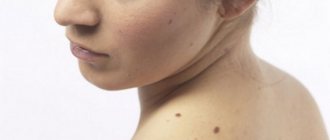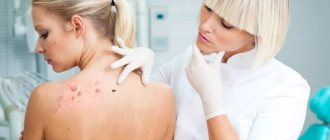Why do they appear?
Like warts, papillomas are not dangerous
.
Their appearance is associated with the human papillomavirus (HPV),
which is transmitted through contact with a carrier. It is also possible to transmit HPV from an affected area of skin to a healthy one in one person. High humidity and microcracks in the skin increase susceptibility to viral particles. In this regard, you should always use personal hygiene items when visiting swimming pools, saunas and showers.
Important:
a large number of papillomas may indicate problems with the immune system.
For women in such cases, it is necessary to take a smear for HPV, since some of its types can cause cervical cancer
Types and features of localization of papillomas in children
Parents are often frightened by the variety of shapes and colors of epidermal growths on the child’s skin. This is due to the fact that medicine has identified about 120 different strains of HPV, each of which is manifested by specific visual characteristics and localization on the body. Children most often encounter the following types of papillomavirus:
- Ordinary papillomas - appear in the form of small oval or spherical bumps on the skin (warts) that can have different colors. Ordinary papillomas are most often localized on the hands (back of the hand), on the scalp and buttocks, but can appear in almost any area of the epidermis.
- Flat papillomas - the second name for this type of neoplasm - juvenile warts, however, quite often small small papules the color of healthy skin appear in infants. Most often, such papillomas are localized in a child’s face, head and hands.
- Papilloma of the throat - especially often manifests itself as a consequence of infection of the baby during childbirth and can be accompanied by a change in voice and difficulty breathing. Papilloma on the tonsil in a child can manifest itself for a long time as unexplained discomfort in the neck area.
- Plantar papillomas - form as single warts on the foot and can cause pain when walking and especially running. Such structures can result from damage to the skin of the foot and prolonged wearing of compressive or, on the contrary, too large shoes.
- Thread-like papillomas are round or oblong formations that usually form in the area of skin folds: (on the neck, in the armpits, in the groin area, on the face in the area of the nasolabial triangle).
- Epithelial hyperplasia is visually diagnosed as excessive growth of mucous membrane tissue, which, like classic neoplasms, is of a viral nature. Hyperplasia can appear as small papillomas on the child’s lip, as well as on the surface of the tongue or palate.
Most types of papillomas that affect children do not exhibit pronounced oncogenicity, that is, they are not inclined to cause an oncological process, however, to clarify the diagnosis, you should still consult a specialist.
What is the best way to treat?
A large number of papillomas certainly causes inconvenience and does not look aesthetically pleasing. However, this is not a reason to use old-fashioned methods for removal with thread, pliers or a blowtorch.
For single small (1x1 mm) formations, celandine juice
- a proven folk remedy.
When there are many papillomas or they are large, this method is not suitable
, as it can last for months and lead to severe inflammation.
Removal using radio wave surgery is much more convenient and effective
The operation does not require special preparation, is practically painless, and after it you can drive a car.
Once I had the opportunity to remove about 70 papillomas from one patient at once. It is difficult to convey all the joy of a person who got rid of them, whom they tormented for several years.
Seborrheic keratosis
Or keratopapilloma, “senile wart” - the most common benign human tumor, manifested by both single and multiple warty plaques of a round shape covered with dense crusts that are greasy to the touch from yellow-brown to gray-black. The appearance of the first elements can begin at 35-40 years. Favorite localization: face, chest, back. For an experienced dermatologist, diagnosing the disease is not difficult, but in some cases a histological examination is required. The reason for contacting a doctor is a cosmetic problem or the patient’s concern about the possible malignancy of the process. There are many methods for treating seborrheic keratosis, the most effective, in our opinion, is removal with CO2 laser beams.
Orlov Alexey Vladislavovich, dermatologist, CMN
> See also in the section pediatric dermatology: removal of warts
Treatment results
The photo below shows the results of removal of neck papillomas using radio wave surgery
Rarely occur again. Reappearance of papillomas is possible with high virus activity in the body. In this situation, additional treatment with immunomodulators or consultation with an immunologist may be required.
Removal of papillomas and skin tumors with laser and liquid nitrogen
We provide the following types of services:
- Removal of papillomas for children with nitrogen or laser
- Removal of skin tumors in children
At the Healthy Generation clinic, papillomas are removed using the most painless techniques and modern medical equipment. Caring for the health of you and your child is our main goal. The Center’s doctors are ready to see you and provide all the necessary assistance in the treatment and removal of skin lesions. Phone numbers for inquiries.
Tests for diagnosing HPV and immunogram
HPV is detected by cytological and histological methods.
Early diagnosis, before the appearance of clinical signs, is carried out by detecting antibodies to the virus.
But this method is not suitable for determining the concentration of the infectious agent.
It has low accuracy for determining the type of papillomavirus.
Together with the cytological method, the Daijin amplification test is also used.
With this new and very accurate test, the concentration of HPV and its specific type are determined.
This means you can find out the degree of oncogenicity of the papillomavirus.
To carry it out, scrapings from the mucous membrane of the vagina or urethra are needed.
The non-amplification PCR method is also used to diagnose HPV.
The material for analysis by this method is smears from the mucous membrane, blood and urine preparations.
If papillomavirus DNA is detected, then we can speak with almost one hundred percent certainty about HPV infection.
But if the analysis technology is not followed and gross errors are made, then false positive or false negative results can be obtained.
The experience and responsibility of a specialist is very important.
To assess the state of immunity, at the moment, it is very advisable to do an immunogram analysis.
This is a comprehensive blood test that does not strictly take into account indicators of the degree of immune response.
Typically, an immunogram consists of immunophenotyping, analysis of humoral parameters and tests for phagocytosis activity.
Methods for treating papillomas on the forehead of a child
There are 4 ways to solve the problem: taking medications with antiviral and immunomodulatory effects, using external agents, including cauterizing agents, treating papilloma on a child’s forehead with folk remedies, or performing physiotherapeutic procedures to remove formations. The last option is the most extreme, and for its choice there must be compelling arguments - the risk of the growth becoming malignant, poor facial aesthetics, severe discomfort due to this.
Drug therapy for papillomas on the forehead in children
The photo shows medications for the treatment of papillomas on the forehead of a child
This therapy involves prescribing medications to strengthen the immune system, suppress the activity of the virus, and dry out formations. They can be in the form of tablets, syrup, spray, cream, ointment, or powder for preparing a solution. For greater effectiveness in the treatment of papillomas on the forehead of a child, it is recommended to combine internal administration of funds and external treatment of growths.
Below we will briefly describe popular and effective drugs of different types:
- Immunomodulators . Of the drugs in liquid form, we can primarily recommend Cytovir-3, sold in the form of syrup. It is created specifically for children over 1 year of age and is recommended to take 2-12 ml every day. The optimal number of doses per day is from 3 to 5. Older children can take the same drug, only in capsules, which should be taken 1 piece at a time. every day for a week at least. An analogue of this powerful immunomodulator is Arbidol in all forms of release - suspension for solution, capsules, tablets, as well as Cycloferon. Of the liquid homeopathic preparations, the tincture of ginseng and Echinacea purpurea, Lymphomyosot, best copes with its task.
- Antiviral drugs . They are prescribed for papillomas on the forehead of a child only in addition to immunomodulators, but very often they also have an immunomodulatory effect. First of all, it is worth highlighting Anaferon - children's drops for oral administration. It can be prescribed to a child older than 1 month, that is, almost immediately after birth. If necessary, this medicine can be replaced with Lykopid, presented in tablets that should be taken 1 piece at a time. per day, without drinking water, but placing it under the tongue and dissolving. An alternative to this option could be Kagocel, which is suitable for children over 3 years old, or Ingavirin for children in capsules.
- Vitamins . To strengthen the immune system for papillomas on the forehead in children and increase hemoglobin, you will need complexes containing iron, folic acid and other useful substances. Good dietary supplements include Vitrum Baby, produced in the USA. It is indicated for children aged 3-5 years. If he is older, but not yet 8 years old, he can take the Alphabet "Kindergarten" course. A fairly effective drug is Complivit-Active, which is usually prescribed to primary school students. As an option, you can offer “Baby” tablets with raspberry-strawberry flavor from the Multi-Tabs brand, which are chewed until completely dissolved in the mouth.
Read the review of Lapis pencil for papillomas and warts.
External remedies against papillomas on a child’s forehead
In the photo, the solution “Verrukacid” for papillomas on the forehead in children
For young children, papillomas on the forehead can be lubricated with Viferon gel
with anti-inflammatory properties. This should be done 2-3 times a day for 1-2 weeks.
solution “Super Clean” can serve as a replacement.
, safe for the child's health. It should be applied to the formations 1 drop per day and left until absorbed.
, the “Verrukacid” solution will work no worse than Supercleaner.
, which is intended for processing formations for the purpose of drying them. The procedure is carried out 3-4 times a day using a cotton pad. Treatment should last at least a week.
Aldara cream and Panavir gel may be even more effective.
, but they are recommended for children over 14 years of age.
Folk remedies for papillomas on the forehead in children
Before using any folk remedy, you need to conduct a test - treat the skin on your elbow with it and monitor its reaction. As a result, there should be no redness, itching, or peeling.
Among the available options, you can stop at lemon juice
, which is sold in the market and in stores all year round. It should be used fresh, just squeezed out, to wipe papillomas on a child’s forehead using a cotton pad.
An extract from young aloe or celandine leaves can also be a good remedy.
. You can also simply apply them to the growth, fix it with a bandage and plaster and leave it for a day until the problem is resolved.
Potato juice or potato pulp helps a lot
, as well as onions. They can be rubbed onto papillomas on children's foreheads 2-3 times a day and used as compresses.
You can do the same with red rowan and garlic.
. They should be applied to the growth for 10-15 minutes, after which the skin should be wiped with a damp cloth.
- See another recipe: Onion gruel for papillomas
What is papilloma?
Papillomas are benign neoplasms. In most cases, they affect the surface of the skin, although sometimes the mucous membranes are also at risk. This is a viral disease that a person can become infected with at absolutely any age; Among children, it is most often found among schoolchildren.
Other benign formations in children are hemangiomas. Here you can see a photo of a skin hemangioma.











